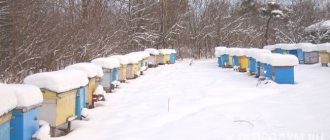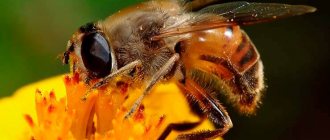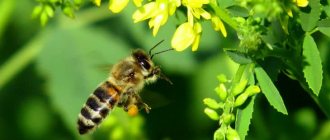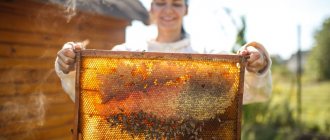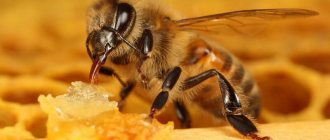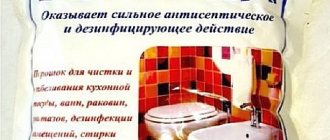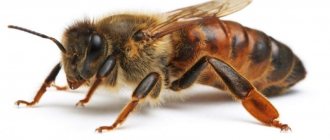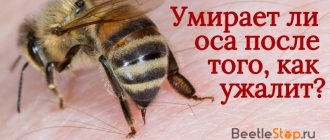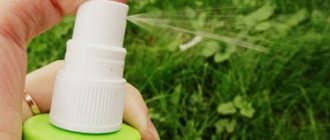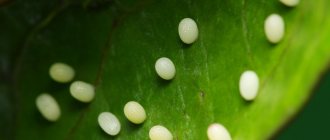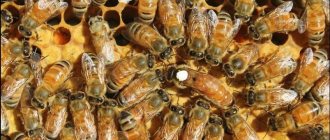Bee family (queen bee in the center)
Honeybees, like other socially living insects, do not live long outside their swarm and die quickly. But they will not live in someone else’s family either, accepting only their own way of life and their own hive. A complete bee colony consists of one fertile queen , several hundred drones and several tens of thousands of worker bees . Let's consider the features of their structure and behavior.
What is a bee colony?
Thanks to the dependence of each family member on each other, a huge amount of pollen and honey is collected, and optimal temperature and humidity are maintained in the hive compartments. Bees can reproduce and defend themselves from any enemies.
Each bee colony has its own specific characteristics:
- smell;
- polishing nests;
- resistance to winter conditions;
- ability to grow and collect honey;
- performance;
- tendency to get sick;
- level of aggressiveness.
The uterus plays a huge role in the family, after replacing which the conditions may change. This is due to the fact that generations change, and so does heredity.
The family consists of the following members:
- uterus - one;
- working individuals - females with an underdeveloped reproductive system;
- drones are males.
In general, in a family there can be 80,000 bees in the summer, and 20,000 in the winter. Insects can develop intensively mainly under favorable conditions. This is the right temperature, sufficient amount of feed. Bee growth slows down in autumn and stops in winter.
How long do bees live without food?
The lifespan of bees directly depends on the ambient temperature and the period of their birth.
That is, the temperature at which insects feel comfortable is 16.5 C. In turn, 36 C leads to poor flight patterns and a short lifespan of insects.
The period of hatching from the cell is also an important factor in the length of a bee's stay. So the March brood can live up to 35 days, and the July brood up to a month. When honey collection is actively occurring, the bee lives at this rate for up to 25 days. And the brood can live the longest if it is hatched between September and October, up to 100 days.
Due to the unique structure of the large intestine in the rear part of the insect, nutritious sugars accumulate. The folded shape of the intestine allows it to accumulate more food so that it will last until it flies around in the spring.
If the bee is sufficiently saturated, it can go without food for 20 to 135 hours. But this does not apply to bees, which are considered honey bees and work in the summer. Their fasting period is quite short, only up to 17 hours. However, young individuals can last up to 115 hours.
Life of a bee family
The bee colony is characterized by polymorphism, which in translation means multiformity. This is manifested in the presence of a male and 2 types of females. This happened against the backdrop of evolution.
The uterus is not able to work, but only lay eggs. At the same time, she cannot feed and raise offspring or take care of housing. All the work is done by the workers, while the drones do absolutely nothing. Worker bees collect pollen, feed the queen from their proboscis, and set up the hive. Feature - females will not be able to replace the uterus due to underdevelopment of the genital organs.
The lifespan of insects is influenced by the time of year, the strength of the entire family and the amount of sugar processed. Working individuals live for a month or two in the summer, and up to 8 months during rest. Their life expectancy depends on their ability to work (the more they work, the less they live). The life of the uterus reaches 4 years, but under conditions of high-quality care they can live for 5 years.
Based on the integrity of the biological system of the bee family, there are characteristic features:
- Common origin. Drones and bees are born from a single oviparous queen.
- Lack of ability for self-existence, that is, not a single family member can live separately.
- Common functionality. Individuals take care of protection, offspring, and regulate the microclimate in the hive.
- The subtlety and flexibility of the distribution of functions - each type of individual does its own thing.
- Strict obedience to the general rules of the family.
Development
Ontogenesis (development) depends on growth and differentiation (the process of realizing the genetic phenotype of cells in terms of ability and functionality). That is, from the processes that occur in the bee body throughout its life.
Features of development:
- Females develop while in the egg at the moment when the nucleus of the egg fuses with the sperm. The beginning of male ontogenesis is considered to be the period of fragmentation of the nucleus in the egg, which has not yet been fertilized. This occurs against the background of the pre-embryonic type of development, when the egg is formed in the ovaries of the uterus, and sperm in the seminal section of the male.
- After this, the embryonic period of ontogenesis begins, when the embryo develops inside the egg. If the egg is fertilized, then it takes 3 days to develop; if not, then the time increases by 10 hours. On the first day the egg is in a vertical position, on the second it takes an angle of 45 degrees, on the third it sinks to the bottom. A larva is formed inside, which has no visual organs or sense of smell. It is not pigmented, most of the body consists of the midgut. A couple of hours before its release, hive insects fill the cells with royal jelly, due to which the eggs are in a floating state. If there are not enough nurse bees producing milk to feed the larvae of worker insects, then the larvae come out dry (there is not enough bee milk).
Future queens are fed primarily with royal jelly.
- Next comes the postembryonic period, when the worm-like larva emerges from the egg. She does not excrete so that the food does not become contaminated. From this moment until the transformation into an adult insect can take about 25 days. Before pupation, enzymes that synthesize melanin accumulate in the hemolymph, which leads to darkening of the cuticle.
- The prepupa period begins, in which the larva molts 5 times: the first 4 times over 3-7 days. The fifth moult is the final one. Molting is a gradual shedding of the shell as the insect increases in size. At this time, the larva does not need food, because it is actively engaged in weaving a cocoon.
- The pupal development stage is characterized by the 6th molt lasting 9 days. At this time, the insect is formed.
- During the pupa and prepupa period, the queen is in a sealed cell, so she cannot move or feed. Nutrients accumulate in the fat body of the larva. It is these reserves that the female uses.
- Immediately after release, the larva lies on its abdomen and after a day turns over on its side. On the third day he assumes the pose of a half ring, on the fourth - a closed or open ring. On the fifth day the tip with the head rises, on the sixth day the larvae increase to the size of a cell.
- How feeding occurs: in the first 3 days, the larvae of worker bees are fed milk, after which they are fed beebread and honey. This inhibits the formation of the female genital organs. Body weight increases 1,500 times in 6 days.
- How bees care for larvae: workers fly into the cell 1,000-2,000 times per day to create a special microclimate. The temperature should be 35 degrees, humidity - maximum 80%. After 6-7 days, the cells are sealed with specific lids that will ensure normal air exchange. The lid consists of pollen and porous wax.
- 21 days after birth, the bees gnaw through the created lid, going outside.
Distinctive features of color development:
- immediately after pupation, the color of the compound eyes is white;
- on the third day it acquires a yellow tint;
- on the 4th – pinkish;
- on the 16th - purple, with the chest resembling ivory;
- 18th day – dark abdomen, joints and claws – yellow-brown;
- 19th - the breast becomes even darker, the eyes acquire a purple tone;
- 20th day - the body looks dark gray.
Development after going outside:
- When leaving the cell in cloudy weather, the bee must rest for 3 days. Adults feed it, but it itself can feed on the remains of the lid. During this time, the young working female puts herself in order, after which she begins to clean the cells. Some insects polish them to a shine with propolis.
- Up to 7-10 days, the young live near the uterus, feeding her and the growing larvae. During this period, milk is produced in sufficient quantities. Larvae 4-6 days old are fed until 6 days of life. Next, the youngest are fed.
- After a week of age, the young individual develops wax glands, so wax is secreted in the form of plates. Bees become builders - they compact pollen, process nectar, and build honeycombs.
- After 2 or more weeks, wax glands stop being synthesized, so the insects switch to caring for the nest - cleaning the cells, collecting and removing garbage.
- After 20 days of life, bees acquire guard status. They guard the entrance and are able to distinguish between alien individuals. For the first time they begin to fly out, which makes it possible to remember the clear location of the hive. The insect flies exclusively with its head towards the entrance, making semicircular movements.
- When the age reaches 22-25 days, worker bees fully fly outside the “house” to collect honey. The collector must inform other individuals about the location of the nectar. She does this through visual biocommunication.
- After one month of age, the bee collects water for the whole family. This period is characterized by a high mortality rate of insects, since they often collect water from natural sources. To prevent this, the beekeeper must take care of the presence of drinking bowls with high-quality water in the apiary territory.
This cyclical activity of bees makes it possible to more rationally utilize nutrients and use the available number of family members. Nutrients are most abundant during the period of exit from the cell.
If the queen or brood dies, the beekeeper needs to establish at what period this happened. Therefore, it is extremely necessary to know what characterizes each stage of development.
Content
In order to increase the productivity of a bee colony, it is necessary to properly maintain the apiary. There are rules that are mandatory during the honey collection period:
- processing and pumping of honey;
- timely and high-quality feeding;
- lack of swarming process;
- organization of family work;
- arrangement of winter quarters.
How to properly keep bees:
- The standard parameters of the socket are 9 mm, but innovative developments increase this gap to 12 mm. Relevant for multi-part content. But this leads to an increase in feed consumption during wintering. Undigested food remains accumulate in the hind intestines of insects, so after exhibiting the hive in the spring, bees must fly around to clean. Deviation from natural parameters (in a hollow, log) provokes early swarming, which is beneficial for the beekeeper - the family reproduces and settles earlier and better. Read more about bee reproduction in different ways here.
- Approximately on the third day after the opening of the hives in the spring, workers bring pollen to the nests, and the queen lays eggs. During this period, the beekeeper must expand the nests and begin counting 36 days. It follows from this that in 20-21 days a new generation will appear (24 days pass after the exhibition). After a maximum of another 12 days (36th day), the young animals will begin to rebuild the cellular frames, so the hive must be provided with foundation. If all the work is carried out correctly, maintaining the angle of the base of the cells (should be 110 degrees), then the construction will proceed quickly, the uterus will begin to worm more intensely.
- The beekeeper must place food supplies in the form of honey and bee bread. The arrangement must correspond to natural conditions - beebread frames are installed under the brood.
- If insects are kept in multi-hull hives, then the honeycomb frames are arranged like a pyramid (nests will be formed according to the principle - 7, 9, 11).
- The ceiling part must be sealed, so that heat is not lost. This will prevent the use of waste products of bee insects in air exchange.
- Experienced beekeepers prefer multi-body designs because it is possible to reduce and expand nests with bodies rather than separate frames. This leads to a reduction in human labor costs and an increase in the number of bee colonies. But in this case, stimulating feeding with honey is taken into account. This will replenish food supplies in the brood box in the fall.
- Multi-body maintenance involves carrying out a number of works without inspecting the frames and disassembling the nest: reducing the nest and cleaning the bottoms - removing one body;
- expansion - adding a stern hull;
- installation of a “construction” building;
- transportation of the family for pollination and collection of honey for various crops;
- installation of store stands for placing honey products;
- honey selection;
- preparation for wintering.
Additionally, read the article-instructions for a novice beekeeper.
Wintering of bees:
- Bees are provided with winter rest after the onset of cold weather. The temperature in the hive should be from 0 degrees to +7. It is this mode that ensures the optimal concentration of CO2 (if we talk about the biological optimum, then the concentration should be 1-3.5%). If the temperature and CO2 concentration are higher, the bee colony becomes more active, and this leads to excessive consumption of food and premature diarrhea (excess feces create pathological loads on the hind intestine).
- Winter streets should have a size of 9 mm. This will ensure a normal level of carbon dioxide, which is important for a smooth transition of the bee body into a state of rest.
- For the winter, no more than 5 kg of food is placed in one family.
- During the winter period, the beekeeper must constantly listen to the hives - the club should not create rustling, hum, or buzzing. Bees usually curl in clusters, hanging from the bed. This is a natural feature of insects to create an optimal microclimate.
How does the time of year affect the number of bees in a hive?
The life activity of the bee family is directly related to the external environment. Temperature fluctuations and weather changes affect the performance and level of aggressiveness of insects. In regions with pronounced climatic features, two periods are distinguished:
- active;
- calm.
In the spring, brood is raised in the nest as fresh food becomes available. The egg production of queen bees increases. Old insects die. The number of new ones is increasing. Families are strengthened. With the beginning of honey collection, a bee nest can contain up to 2 kg of individuals. After three to four weeks, their numbers double.
With a sharp increase in numbers, there is not enough work for the inhabitants of the nest. If difficulties arise with collecting nectar, then the tension of life in the bee colony decreases and an instinctive need for swarming arises. The functionality disappears:
- the number of departures is reduced;
- construction of honeycombs is suspended;
- bee brood decreases;
- the level of education of young animals is falling.
The duration of honey collection in the regions depends on weather conditions and plants. A strong family can collect up to 15 kg of nectar in one day in warm weather. Bee communities weighing up to 8 kg are capable of producing up to 150 kg of honey. Working honey plants quickly die under this mode of life. The number of insects after the bribe drops almost 2 times.
The temperature in the nest during honey collection rises to +350. At rest – +150. It will increase only in the spring when the bees start brooding. On frosty days, carbon dioxide levels rise and oxygen levels fall. This mode saves food supply as the metabolic rate slows down, allowing the insects to survive the winter.
Uterus
There is only one and the main queen for the entire family of thousands of bees, which is why she is called the queen and queen of the hive. She is the only one of all females who has a normally developed reproductive system. Responsible for fertilization and brood reproduction. Its quality is determined by the number of eggs laid. The queen should hatch 1,700-2,000 eggs per day. If the queen bee cannot cope with her duties, she is exchanged for another individual.
Each worker bee and drone distinguishes its queen by a specific smell, so if a new queen is introduced into the hive, the family will perceive her as a threatening enemy, which will be followed by destruction. For this reason, one family cannot have two queens at the same time.
Distinctive features
A queen that has copulated with a male at least once is considered fertile. Her features, unlike other females and drones:
- weight ranges from 180 to 330 mg (barren weighs 170-220 mg);
- body length – from 2 to 2.5 cm;
- eyes are smaller than others;
- the abdomen is torpedo-shaped;
- body elongated;
- the queen is characterized by increased slowness;
- lives mainly in the hive (leaves the house only during mating and swarming);
- lifespan – 4-5 years;
- has a special smell that comes from the pheromones it produces;
- She is the only one of all bees who does not die after releasing her sting.
After a couple of years, the queen’s reproductive capacity decreases and she produces fewer eggs. Moreover, mostly drones are born. Therefore, beekeepers replace it with a new one during this period.
Functions
The main function of the uterus is to procreate and lay eggs. It is she who unites the entire genus, secreting a special substance that is transmitted to all members of the family. The owner of the hive directly affects the overall productivity of bees, their vital activity and numbers.
Removal methods
The uterus is removed in 2 ways - naturally and artificially. In the first case, the insects themselves rebuild the queen cell, where the queen lays her egg. In order for the queen to be born, the larva is fed with royal jelly, which contains a special hormone.
Artificial breeding includes the following stages:
- The host bee, along with the open brood, is removed from the hive (only larvae and recently laid eggs remain inside).
- The lower part of the honeycomb is trimmed.
- The queen cells are cut out and placed in the hive.
- Return the uterus to its place.
There is another technology for breeding queens, but it is used extremely rarely, as it is considered complex. But experienced beekeepers try to use this particular method, because it makes it possible to obtain fertile and highest-quality queens. The essence of the method is to place the larvae in wax sacs and artificially feed them with royal jelly.
To produce a good hive owner, follow these rules:
- use the strongest families;
- distribute queen cells evenly throughout the swarm to ensure complete feeding;
- maintain a favorable air temperature (32-33 degrees);
- consider humidity (60-80%);
- adhere to the breeding calendar;
- control the process of fertilization and the appearance of layering.
Pairing
To mate, the queen performs a nuptial flight, after which fertilization immediately occurs. This happens within 10 days after leaving the queen cell. The process goes like this:
- In the first 3-5 days (depending on the age and strength of the uterus), the queen rests. The beekeeper must destroy the remaining queen cells during this period.
- Next, the queen flies out, remembers the location of the hive, and navigates the area.
- On the 7th day, mating flight takes place. The drones, having sensed the pheromones of a bee ready for mating games, quickly follow it. However, only the strongest and fastest individuals can catch up. After mating she comes back.
- After 3 days (on the 10th day after emerging from the queen cell), the queen carries out primary seeding.
It is strictly forbidden to frighten the female these days, as she usually flies away a long distance. In an unfamiliar area, the uterus does not orient itself, so it will never return back (it will die).
If it happens that you need to disturb the hive during the mating period, follow the recommendations:
- When inspecting, proceed with caution, do not use smoke substances or other products that irritate the bees.
- It is permissible to inspect the hive until 11 o'clock in the afternoon.
- Honey should be collected after insect flight activity has subsided, that is, after 5 pm.
Uterus replacement
Bees always sense when their queen has died. A person can also notice this, because the insects begin to fly quickly in search of the mother and make a lot of noise. About 2 hours after this they already feel like orphans.
If a beekeeper artificially replants a bee, then this should be done 10-12 hours after the death of the old queen. As mentioned above, a bee colony can replace the queen on its own. Insects sense when the queen is aging (her scent changes) or is damaged.
Self-replacement is carried out in quiet ways:
- Separation is carried out with an available female. The family needs to be divided into 2 equal parts and 6 frames with dry food should be selected. Period – after one-day sowing. In the part where the queen is absent, the bees will independently lay a queen from the larvae. After the new uterus gets stronger (about 4-7 days after birth) and the family gets used to it, the two parts are put back together. A stronger and younger individual destroys the old one.
- Damage to the queen. The beekeeper must take the uterus and artificially damage it. Working insects destroy it after a while, and then hatch a new queen.
Artificial creation of queens:
- Replanting. A cap or cage is used. Remove the cage from the hive and place the queen bee on it so that she does not fly away and leave her scent. After a couple of hours, the old queen is removed and the young one is introduced. Next, the cage is installed in the upper frames in the center of the nest. Wait 2 hours. Working insects must feed it. If the result is positive, the cell opens. They work with caps in the same way. But the bees will make their way to the new queen through the honeycombs. There is a risk that the young individual will not be accepted. Then you will have to repeat the procedure with another new uterus.
- Shaking off. The family must be abruptly shaken off into the entrance or into the hive, which will cause the insects to become confused and forget about their queen. At this time, add a new “mother”. However, the method does not always pay off, as the bees simply start to get angry.
- Aromatization. An effective method. The glue, swarm and young queen are sprayed with sugared water, a solution with mint drops. This makes it possible, in the process of licking a new individual, by bees to get used to its smell and accept it.
- Replacement with mother. In the evening you need to take an empty lei and sprinkle it with mint drops. In the morning, you need to form a layer of young animals, placing them next to a strong swarm. In the evening of the same day, a young queen is introduced, which makes a flight. When the time of fertility arrives, both families are reunited. The old mother is destroyed by bees.
- Sprinkling. It is used when the old uterus has died. In the evening, they seat the young mother, but first cover her with a cap. In the morning it is removed, and the insect is sprinkled with regular flour. This method has been proposed on the Internet, but has not yet been tested by beekeepers.
Bee Reproduction
Reproduction is the main form of conservation of living species. The biology of bees as a single organism determines the form of bee reproduction as the division of one whole (large) family into two or more. The reproduction of bees is called swarming. From early spring, bee colonies try to raise as much brood and young bees as possible.
They build or remake tinder cells from bees (bring out drones) and build bowls for the queen cells of future queens. The number of queen cells laid is on average from 5 to 10. The bees reduce feeding of the queen, her weight decreases, and she becomes capable of flight. As soon as the first queen cell is sealed, approximately on day 1 - 2, reproduction begins - the emergence of the first swarm.
Subsequently, swarms continue to emerge as the queen cells mature and the infertile queens emerge. So one strong (large) family can be divided into several independent bee families. Not all of them will be able to develop sufficiently, prepare and survive the winter. But the process itself is necessary as a means of survival for the entire species.
Drones
Drones are males that exchange food with worker bees. At the end of summer, the latter stop feeding the brood of drones, not allowing adult males to eat their food. Moreover, they begin to drive them out of the hives.
This indicates the end of the main honey collection period. Therefore, such individuals usually do not survive until wintering. But this is only possible if there is no queen in the swarm. For many beekeepers, drones are a burden, since they do nothing other than mating, but they eat nutritious food and infect other members of the colony with varroa.
Distinctive features
Males appear during the period before the honey harvest, that is, at the end of spring. Approximately on the 10th day after emergence, the drone can fully mate. The number of these insects ranges from 200 to several thousand. Characteristics:
- weight – 220-250 mg;
- body length – from 1.5 to 1.7 cm;
- the body is wide;
- rounded tail;
- during flight, high speed develops;
- at rest they are clumsy;
- quickly navigate in space;
- when flying they make loud bass sounds;
- there is no sting;
- fly away from the hive 15 km;
- death occurs after mating;
- development period – 24 days.
Functions
The drones' only function is to mate with the queen of the hive. Drones are constantly fighting for the right to mate with the queen. The strongest win, but immediately die. Males that have never mated die of starvation after being expelled from the family.
The beekeeper can observe the mating process, noting weaker individuals. This makes it possible to artificially cull them, so that the queen will only have strong and fertile males.
Life cycle
Males live a relatively short life - up to 3 months. The time of their appearance in spring is determined by climatic and weather conditions, the age of the queen, the bribe, and the strength of the swarm. When hatching drones, their cells are located around the perimeter of the honeycomb, but if there are not enough of them, the bee places the larvae directly on the honeycomb.
After leaving the cells for a decade, the worker insects artificially feed the males. This is necessary for the full formation of the latter. A week after emergence, the male makes his first flight, familiarizing himself with the location and environment.
Controlling the number of drones
The number of males in a bee colony largely depends on the quality of the honeycombs and the breed, but each family naturally rejects weak individuals. However, it happens that too many drones are bred, which negatively affects the swarm and the amount of honey collected, so beekeepers must control their number. Normally, 200-500 males are enough.
A family cannot exist without males, and not only because they are needed for mating. It turns out that they can be used to judge the quality of the queen and the swarm as a whole. So, if after expulsion in the fall drones still remain in the hive, this indicates that the queen has become infertile or has died. In addition, when the air temperature drops, the males, flying into the hive, huddle together in groups, creating favorable conditions in the “room.”
If the males manage to overwinter in the hive, they will die in the spring, since they cannot tolerate low temperatures, as a result of which they become weak.
How long does a bee live after stinging a person?
A bee is an insect just like a mosquito. Therefore, in the presence of an irritant, it can bite and not just leave a pleasant memory. The main thing is to remove the sting left by the insect in time.
If you look at such a bite from the point of view of benefits, then this is a kind of useful therapy. When a bee bites you, it loses its sting and injects a certain dose of poison into the bitten area. A snake operates on a similar principle. Bee venom begins to act much faster due to the large number of auxiliary enzymes.
Worker bees
Working individuals have an average life expectancy between the queen and the drone - from 30 days to several months. If a bee is hatched in March, life is 35 days, if in June - a maximum of 30, if in autumn - 3-8 months. But it also happens that insects exist for a year (when there is no brood in the nest). The reason for this is increased nutrition with beebread, due to which reserve substances accumulate in the body. In addition, there is no need to waste energy working in winter.
In the autumn, after honey collection, working females increase their body weight by 15-19%. These individuals have an underdeveloped reproductive system, but despite this, in the absence of a queen in the swarm, they can lay 20-30 eggs. However, they are all unfertilized. Laying occurs not at the bottom of the cells, but on the walls, which distinguishes the working individuals from the queen.
There are two types of tinder bees: anatomical (eggs begin to develop in their ovaries) and physiological (these eggs are laid). The former can be up to 90%, the latter – 25% for the whole family.
Flying and hive bees
Worker bees are divided into two main groups:
- Hive - those individuals that are in the hive after leaving the cells. At first, they gain strength, after which they begin to feed the larvae, then they are engaged in cleaning the hive and construction. When the time comes for departure, they make preliminary flights, turning their heads towards their house. After familiarizing themselves with the territory, hive bees become flightable. They are replaced by newly born individuals.
- Flight - collect pollen and nectar, transport water and sticky resinous substances to the hive. They are the ones who work hard during the honey harvest period.
Distinctive features
There are up to 80,000 worker bees in one bee colony during honey collection, but in the off-season their number decreases significantly - to 30,000. Features:
- Weight – 90-115 mg.
- The length of the body is 1.2-1.4 cm.
- Particular attention should be paid to their body temperature during work, as it depends on the air temperature. If it’s +23-26 degrees outside, then the body has a temperature of 35-37, if the air is 36-37 degrees, then the body is +42. Thus, after the working process, the body is hotter than the air.
Functions
What does a worker bee do?
- collects nectar and pollen;
- produces honey;
- deposits honey reserves in combs;
- builds honeycombs;
- feeds the brood;
- cares for the uterus;
- brings water;
- cleans the hive, rubbing it with propolis until it shines;
- controls the level of microclimate in the house;
- protects the nest (working individuals produce a toxic substance apitoxin, which they use to sting enemies to death).
Stages of bee brood formation
“Queen” carefully controls the quality of the masonry. Moving through the honeycomb and finding an empty cell, it immediately lays an egg. When the queen leaves unfilled “houses” and many unfertilized eggs, she is considered sick or weak. After laying the eggs, workers place food nearby for the larvae. Once out of the egg, they feed heavily.
Growth continues actively. When there is no longer enough space in the “house,” the cell is sealed and a pupa is formed. Closure is necessary for the development of necessary organs:
- legs;
- wings;
- compound eyes;
- mouth
A white bee is formed. The body gradually changes color and darkens. The insect takes on “its” color.
All prepupa larvae are closely cared for by adult family members. Approximately up to one and a half thousand visits per day. Honey and pollen are added to the diet on the second day.
At the final stage of formation, the nurse is constantly next to the larva. Growth occurs so quickly that a new individual sheds its skin once a day.
A bee travels a long and interesting path from an egg to a fully developed insect in a short period of time thanks to careful care and increased nutrition.
